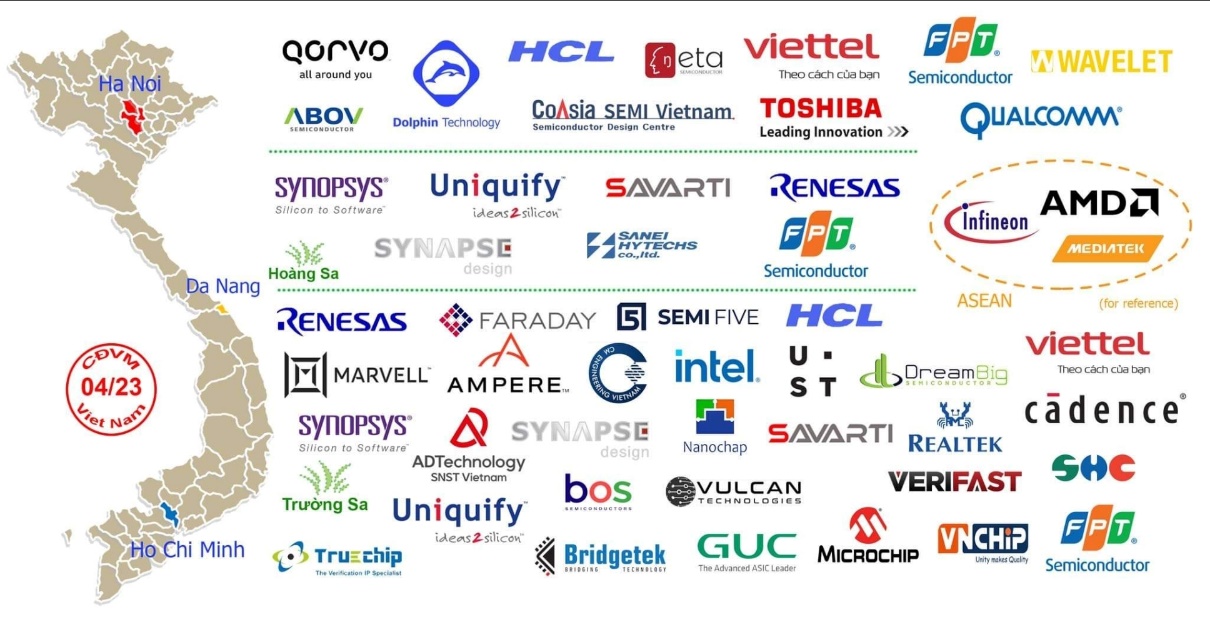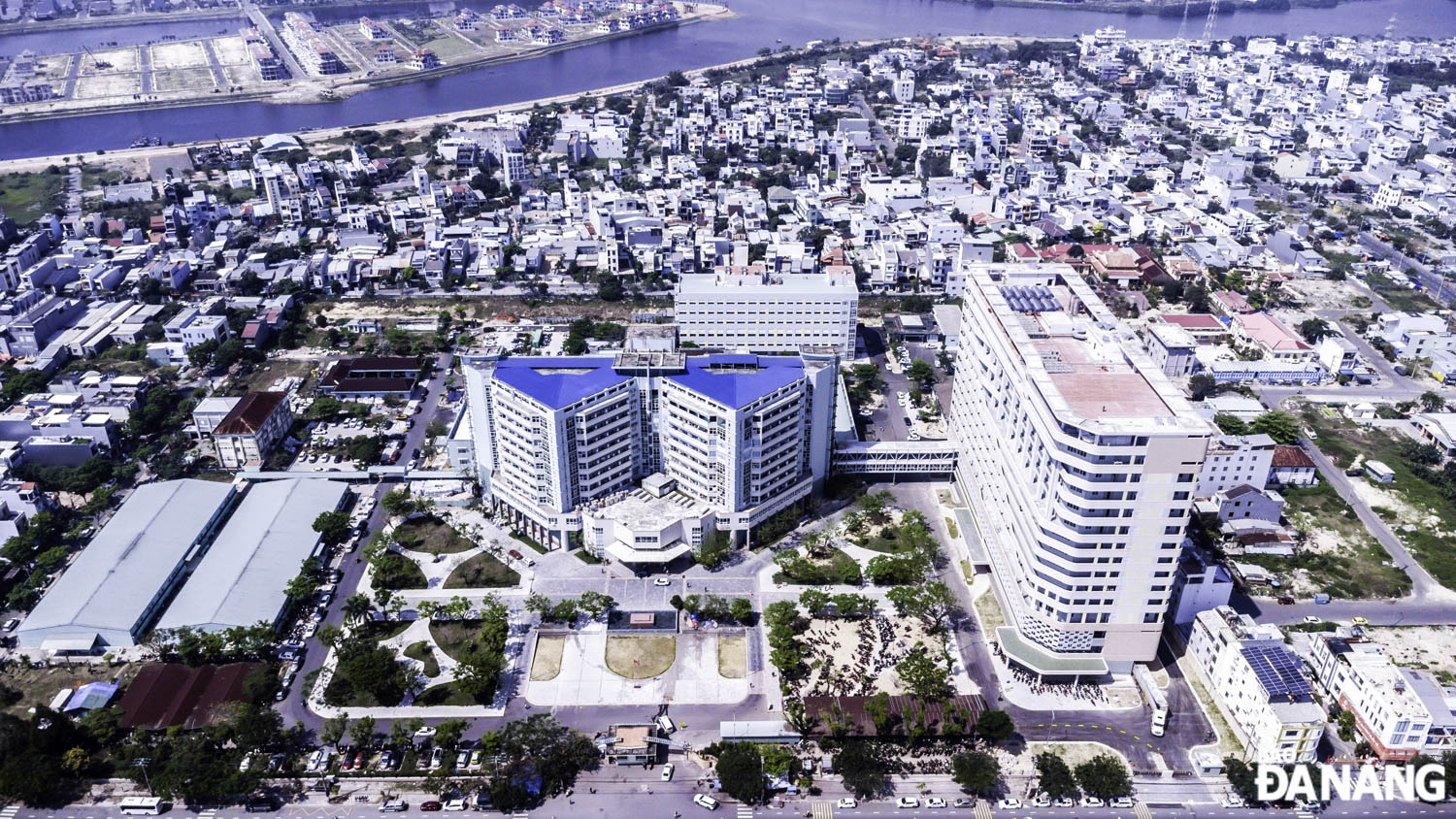It's high time to develop Da Nang human resources for IC design and production
The semiconductor IC industry provides the technical foundation for many areas of modern life, and is an important part of global technological and economic development. In daily life, we often come into contact with and use products that more or less contain semiconductor chips. Prof. Jen Fuhua, famous for microchips at the Minghsin University in Taiwan (China), once affirmed: “If I were allowed to consult Taiwanese businesses on whereabouts in Viet Nam to invest in chip production, I would recommend Da Nang...”.
 |
| The electronics and semiconductor industry is increasingly developing in Viet Nam. Here is the map of microchip companies in Viet Nam. |
After US President Joe Biden's visit to Viet Nam with many commitments and practical actions, Viet Nam expects to develop the semiconductor industry to new heights, instead of outsourcing as currently. To have a qualitative change and create a breakthrough in this industry, human resources play a particularly important role. Under a recent resolution, the Prime Minister requested relevant ministries and branches to research and develop a project for human resource development for the semiconductor industry until 2030, which is expected to train about 30,000-50,000 human resources and experts.
Shortage of human resources in the semiconductor industry
For the time being, not only Viet Nam, the United States also faces a gap in human resources in the semiconductor industry. The results of the survey ‘Chipping Away: Assessing and addressing labour market gap facing the US semiconductor industry’ show that, by 2030, the country’s semiconductor industry will face a shortage of 67,000 highly-skilled professionals.
Viet Nam is considered to be a potential market for the semiconductor industry; however, according to data from the Ministry of Information and Communications, our country's semiconductor industry needs 10,000 engineers per year, but the current human resources are only less than 20% response.
In Viet Nam, a number of universities have provided training in semiconductor technology such as the Ha Noi University of Science and Technology, the University of Information Technology and Ho Chi Minh University of Science and Technology, part of Ho Chi Minh City National University. As for Da Nang, the University of Science and Technology, a member school of the University of Da Nang (UD), has established the faculties of Electronics and Telecommunications, Information Technology in preparations for the semiconductor technology industry.
Training human resources for IC design requires investment from the national government, with policies focusing primarily on the IC industry. The United States, Taiwan (China), S. Korea and Japan all house successful microchip companies thanks to preferential policies from the national government and localities. Providing an interesting learning and working environment with challenges for students can help them improve every day and become excellent IC design experts.
Viet Nam, and Da Nang in particular, have great potential to train human resources for IC design because there are many advantages and supporting factors. That is the acumen and quick action taken by the city's leaders by directing the issuance of specific resolutions on developing the city's IC design field. Da Nang's population is young, hard-working and dynamic, creating favourable conditions for training new human resources in the field of IC design. The city's geographical location is also convenient for sea, road, and air transportation and it has a hi-tech park, a pillar for the city’s future development.
In Da Nang, many universities are training majors related to microchip manufacturing that are trusted and highly appreciated by employers. According to data from the National Science and Technology Information Portal, human resources in the microchip industry are concentrated mainly in Ho Chi Minh City (more than 85%) and partly in Ha Noi (about 8%), and Da Nang (about 7% - 8%).
In Da Nang, there are currently companies operating in IC design such as: Synopsys, Uniquify, Savarti, Renesas, Synapse, Fptsemi, Sannei Hytechs with about 550 engineers, of whom more than 80% are UD alumni. In particular, Da Nang won the first prize ‘Viet Nam Smart City’ for three consecutive years. The city has cooperated with many countries and has experience in training human resources for IC design, so it is easy to share knowledge and techniques as well as training programme development.
Focus on promoting advantages and potential
Developing human resources for IC design in Da Nang requires strong support and commitment from the local government. The experience of previous and successful countries in this field shows that the first thing Da Nang needs to do is develop a strategy and long-term development plan for the field of training and developing human resources for IC design and manufacturing. This strategy should identify specific goals, required resources and development directions.
The municipal administration needs to propose to the national government to support the IC development project and spend part of the funding providing financial support for training and research programmes in the field of IC design. In addition, there needs to be a mechanism to create favourable conditions so that universities and training centers can have enough modern facilities and equipment to support the learning and research process.
It is also need to strengthen close cooperation with technology businesses in developing training programmes, supporting equipment and providing internship and work opportunities for students like the model Intel did with the Da Nang University of Science and Technology as well as promoting international cooperation in research and development.
In addition, Da Nang needs to seek and call for at least 1-2 larger microchip businesses and create maximum preferential conditions for their investment plans so that the city can attract more other enterprises active in this aspect.
Especially, if there is a policy to support startups in microchips, domestic and foreign investors will boldly open companies in Da Nang as affirmed by Mr. Nguyen Bao Anh, Team Leader of Synopsys Viet Nam Company-Da Nang Branch. In terms of investment funding for science and technology, local budget sources can provide support for research and innovation projects in the field of IC design by organising competitions, scholarships or promotions for innovation projects.
The design and manufacturing of ICs and semiconductor devices plays a strategic role in the development of the modern world. With the city’s unique advantages and the active role of investment sources, it is hoped that Da Nang will successfully develop human resources for designing and manufacturing ICs, thereby positively contributing to the development of the electronics and semiconductor industry in the central region, and Viet Nam as a whole.
Reporting by Prof. TRAN VAN NAM - Translating by A.THU








